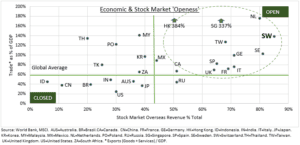CATCH UP: The Swiss stock market is supersized, increasingly attractive, and due a catch up. It’s 14% off its all-time highs, lagging the recent records in US, Japan, and Europe’s Stoxx 600. It’s the global market with the greatest proportion of overseas sales (see chart). Making it very sensitive to the catalyst of the weaker Swiss franc (CHF), as its central bank changes focus. This competitiveness boost should add to the market’s attractive 10% earnings growth outlook. The local SMI index is dominated by defensive consumer staples and healthcare stocks, with an above average dividend yield. Its 17x forward P/E valuation is in line with its long-term average.
CHF: The Swiss Franc (CHF or ‘Swissy’) is -5% this year vs the dollar. This is uncharacteristic. Given its historic safer-haven status, huge 10% current account surplus, FX reserves equal to 100% of GDP, and its traditionally interventionist central bank (SNB). But after a big currency rally last year, inflation down to only 1.3%, and the economy near recession, the SNB is taking a more dovish stance. By halting interest rate hikes early in mid-2023 and its long-standing CHF purchases. It is now cracking open the door to mid-year rate cuts, if not sooner. Any weaker CHF would have a disproportionate impact given the country’ trade and stock market openness.
SMI: The 20-stock Swiss stock index (XSMI.DE, EWL) is the world’ seventh largest. Supersized vs its $870 billion economy, the world’s 20th biggest. And giving it a 170% market cap/GDP. It is dominated by food giant Nestle (NESN.ZU), healthcare duo Novartis (NVS) and Roche (ROG.ZU), globally systemic bank (UBSG.ZU), and luxury leader Richemont (CFR.ZU). As well as industrials ABB (ABBN.ZU), Sika (SIKA.ZU), and Holcim (HOLN.ZU). Defensives healthcare and consumer staples are over half the index and give it an above average dividend yield. With cyclical financials and industrials most of the rest. Popular tech stocks are under 2% the index.

All data, figures & charts are valid as of 22/02/2024.



